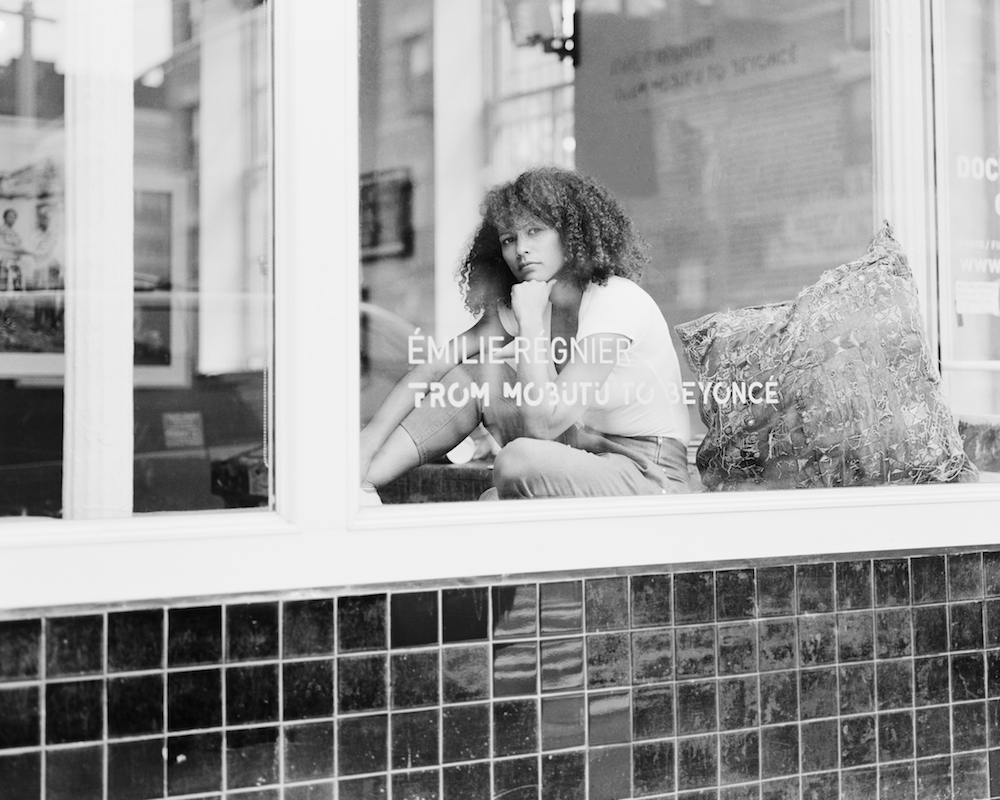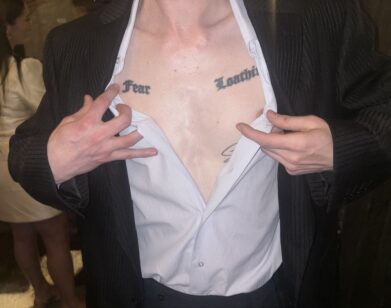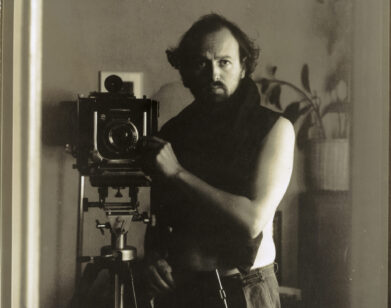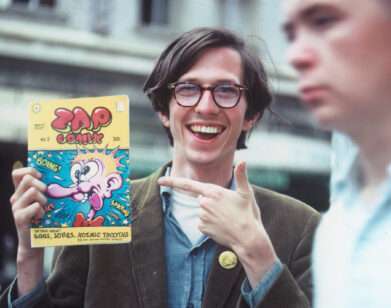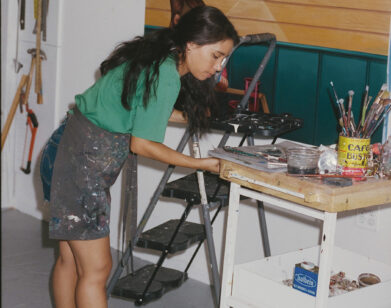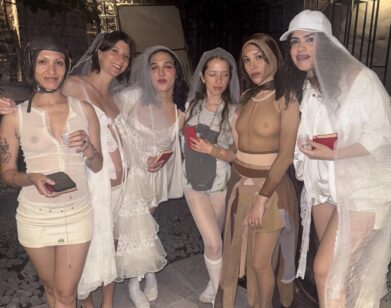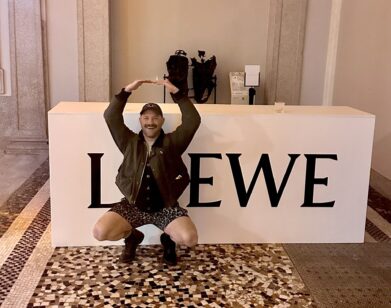Ã?milie Régnier Across Borders
ÉMILIE RÉGNIER IN THE BRONX, APRIL 2017. PORTRAITS: MYLES GOLDEN.
In 2013, a frightening experience in Northern Mali forced conflict photojournalist Émilie Régnier to rethink her career. She turned away from photographing war zones and began exploring West Africa, using photography to “try and make sense of how borders shape who we are.” During her travels, Régnier visited salons and photographed women’s hairstyles; she borrowed a technique from local beauty photographers on the Côte d’Ivoire, and cut her negatives in half, taping together multiple angles of one woman into a single image. Then, when shooting in France, she noticed that a specific fabric print connected many of her subjects: leopard. She met its wearers across continents (in Africa, North America, and Europe) and learned its history: in Congo chiefs wear the pattern to signify political power (a leopard hat was even worn by Mobutu Sese Seko, the dictator of the Democratic Republic of Congo from 1965 until 1997) while in the West, brands like Dior, Gucci, Dolce and Gabbana, Yves Saint Laurent, and Roberto Cavalli have contributed to making leopard what Régnier calls “one of the privileged patterns of couture.”
The two resultant series from this period (2014 to 2016), titled Hair and Leopard, are currently on view in “From Mobutu to Beyoncé,” Régnier’s exhibition at the Bronx Documentary Center in New York. Both bodies of work illustrate methods of portraying beauty and power, and initiate a discussion about identity and the relationship between between Africa and the West. Interview recently sat down with Régnier after the show’s opening to speak about the origins of her two projects, reactions to her work, and her photographic process.
TESS MAYER: Did you have any interesting observations come up on Saturday at the opening?
ÉMILIE RÉGNIER: Yes! It was the first time I showed my work in New York. … I had a lot of black women who came to the show and said, “I’m looking at this photo and I can totally relate—experiencing salons and having all of those haircuts.” That was very interesting and a point I really wanted to reach in this project, for a black woman to come and experience it. A lot of women from the neighborhood came and saw it, and they said, “You could have taken this photo here in the Bronx, and you were in West Africa.”
MAYER: Your leopard dress was great.
RÉGNIER: If there’s one opening where you can put on leopard, it’s in the Bronx!
MAYER: When was the first time you noticed the print and wanted to turn it into a project?
REGNIER: The leopard was when I had an art residency in Paris in 2014. I was taking a photo for a project using these very old Polaroid cameras, I was working in [Paris at] one of the biggest African markets outside of Africa called Chateau Rouge. It’s very diverse, a lot of African communities from everywhere—East, West, Central Africa. While I was spending every day by the subway station trying to find people to photograph that would fit the aesthetic of my project, I saw this woman with this beautiful red afro. I started chasing her and running after her trying to grab her attention and asked if I could photograph her. She was like, “Well, today I am very busy, but call me back and ask me tomorrow and we can do a photo.” The next day she came back and she was wearing a leopard dress. I took the photo, but at the time I was obsessed just by her hair. It’s a Polaroid so I gave her a few photos and I walked home. A few days after that, I’m on the Left Bank at a very bourgeois party, and a lot of rich kids [were there]. There were blonde girls with leopard Dolce and Gabbana. I thought, “Hmm, those two are working together.” Chateau Rouge is one of the most working class neighborhoods in Paris and the Left Bank is on the side of much more rich and fancy. From Chateau Rouge to the Left Bank they are wearing leopard. Then I start thinking, and of course I have a memory of that photo of Mobutu. In Africa, leopard is this big symbol of power that can only be worn by tribal chiefs and kings. In the West, leopard is this big fashion thing. How can we connect the dots? Poor, rich, African, French, Western, American—we all wear leopard, that’s how I came to it.
MAYER: I was reading an article where you mentioned Dior’s collection in 1947.
RÉGNIER: Yes, Dior was considered to be the first one to establish the leopard pattern. Before that it was used to eroticize women. There was a connotation between leopard and sexuality, eroticism, and the savage, like you’re wild. Even if you look at Tarzan and Jane, they were wearing leopard because they’re in Africa. It’s a vision, a reductionist vision, of Africa. If you put this onto women then that makes them into a sexual object. Then Dior took this pattern and made a dress, “The African,” in 1947. The dress was entirely leopard. It was beautiful, haute couture.
MAYER: How did you go about scouting? You have people from Texas, Paris, Congo…
RÉGNIER: The first photo I took in New York in December 2014. I had just the idea in mind, I didn’t have the camera, but I knew I wanted to shoot medium format. I came to New York, bought a camera, and I was talking to a friend who said, “My former neighbor wears leopard.” She put me in touch and she was the first portrait. After that [I photographed] some people I met randomly on the street. I met Nancy [Nancy, Libreville, Gabon, 2015] on a beach in Gabon. Larry here, [Larry, Texas, United States, 2015], I googled “leopard man” and I found photos of him. I added him on Facebook and we were in touch for six months before I went and took the photo.
When I went to the Congo for this project, I knew that finding an archive of Mobutu would be quite easy to find. I was looking for tribal chiefs so I worked with a journalist who introduced me to Chief Matadikibala. When I worked in South Africa I was lucky enough to work with a tourist guide. At first he didn’t understand what I wanted: “You’re coming to Durban to photograph people wearing leopard? You’re sure you don’t want to come on this landscape tour?” I was like, “No!” He took me to a Zulu gathering that was happening the day I got there. That’s where I took the photo of the two women [Zanelle Domo and Philo Dlama, Durban, South Africa, 2015]. Zulu gatherings are done a few times a year in order to keep the culture alive.
MAYER: Everyone in your images exudes a pretty strong sense of pride and confidence.
RÉGNIER: I don’t know if you’ve ever worn leopard?
MAYER: I don’t think I have.
RÉGNIER: Well, if one day you wear a leopard dress, you’ll feel it. For this project I had to experience that. I bought some leopard. The pattern is so physical. You have to self-confident to assume it.
MAYER: You have to be in a certain mood.
RÉGNIER: Yes. Some women could wear leopard every day. I’ve been meeting so many people who say, “This is my favorite pattern. I have everything in leopard.”
MAYER: Do you see it all the time now?
RÉGNIER: Me? Not as much as I used to. People around me? I think I could start an Instagram account with all the leopard photos I’ve received from people from all around the world. [laughs] “Oh, I just thought of you! Oh, I just thought of you!”
MAYER: It’s definitely documentary work but there are other aspects at play. You started out as a photojournalist?
RÉGNIER: Yes, I did. Straight photojournalism.
MAYER: What kinds of stories did you cover?
RÉGNIER: I started in Dakar in 2008, 2009, a long-term project on street kids. I covered the Ivory Coast during the beginning of the crisis in 2010. I partly covered the war in Mali but had to move on because I did not want to do that.
MAYER: Was there a moment where you switched?
RÉGNIER: Yes, I switched in 2013. I went to cover the war in Mali and we were embedded with the French army. The hotel somehow got under attack and we were evacuated by the French army. That night, I was kind of cool, and in the morning I got up and thought, “There is no way I’m going back into town.” I had to fight with the French army to keep me on the base. They were like, “We’re not going to be responsible for you. You’re going out—you’re with the journalists. This is your life!”
I was so scared. You feel horrible because you’re on assignment, you’re on commission. You’re supposed to be there and do your job. In a sense, I couldn’t do it for me, and I was afraid to put other people in danger because I was scared to death. So when I got back I started wondering about how I spent all my teenage years wanting to be a war photojournalist: “Okay, now I can’t do that, so what am I doing?” I was drawn to politics and the political issues that were going on in Mali at the time. So, “Let’s renew my visa, and stay and cover, but be clear with my publication.” The photographer who took my photo for my visa used those old Photomaton cameras. I was taken aback. I purchased one of my own in the market in Bamako. Weirdly I had no purpose and no idea of what I was doing when I started this project; I just wanted to photograph beauty.
MAYER: You give all the images back, right?
RÉGNIER: Yes. There are so many women that I never found again—like with Abiba [Abiba Yalupé, Abidjan, Côte d’Ivoire 2014], I did this project in 2014, I saw her again this year. I was like, “Oh Abiba, let me show you. This is my Instagram, this is your photograph!” She was very happy. … It feels super important to give the photos back.
MAYER: What are their reactions like? Were the women impressed that you gave physical prints to them?
RÉGNIER: First of all, those women at the salon, I think they’re used to being photographed. There are those beauty photographers that will crisscross the city to take photos and resell them. They had a sense of it that was a bit detached. But also they were very proud and very self-confident.
MAYER: That Photomaton camera wasn’t the one you used for the double images in the Hair series?
RÉGNIER: No, that is a 35mm Pentax. I cut my negatives. I reproduced a local technique that is done by beauty photographers. In order to save money they will cut their negatives—you can see there is scotch tape. We switched the negatives together and we print two photos on one. You also show the two perspectives of what the haircut looks like.
The photo of Brigitte [Brigitte Adjoua, Abidjan, Côte d’Ivoire, 2014], she was one of the first women I photographed. I felt the full-frame photo of her was so nice. It took me 10 days to be ready to cut the photo. Cutting your negative, as a photographer, is probably the most difficult thing I have ever had to do. And then to put scotch tape on it! That was such a difficult process.
MAYER: Has living in Paris for the last few years changed your view of any of this?
RÉGNIER: It makes me think differently. It makes me desire to work and [think of] how we can build links between each other, between different ethnicities, races, or social economic backgrounds. It feels more and more needed. If you look at the shit that a lot of countries are taking—I’m sorry, but with your Trump and now the right wing in Europe—it’s a big motivator to be in Paris. The struggle is I’m really out of my comfort zone. I feel in Dakar and Abidjan, it was so easy for me to be there. In Paris, I really have to reconnect to a very different society, and a society that I’m not a part of. I don’t have the Parisian codes; I was raised in Montréal and Central Africa. But European codes are quite different. I think it’s good to try to adapt as much as you can, so after that it’s easier to make connections between different environments.
“FROM MOBUTU TO BEYONCÉ” IS ON VIEW AT THE BRONX DOCUMENTARY CENTER IN NEW YORK THROUGH JUNE 4, 2017. A SELECTION OF RÉGNIER’S WORK WILL BE PRESENTED BY MAGNIN GALLERY AT 1:54 CONTEMPORARY AFRICAN ART FAIR IN NEW YORK FROM MAY 5 TO MAY 7, 2017. FOR MORE ON ÉMILIE RÉGNIER, VISIT HER WEBSITE.

